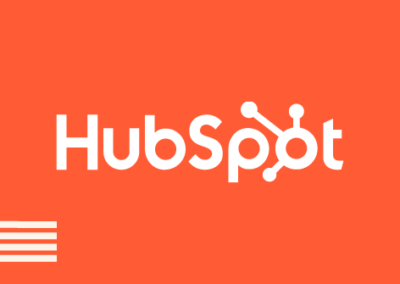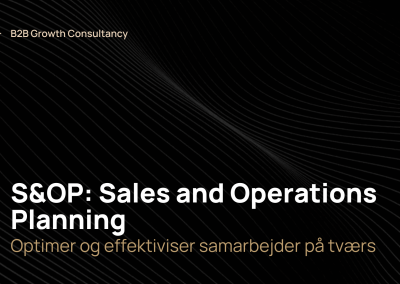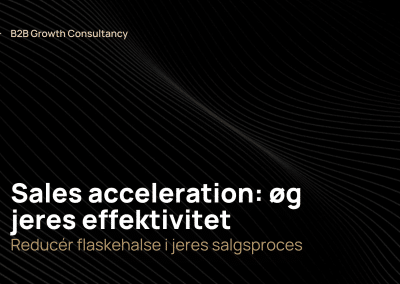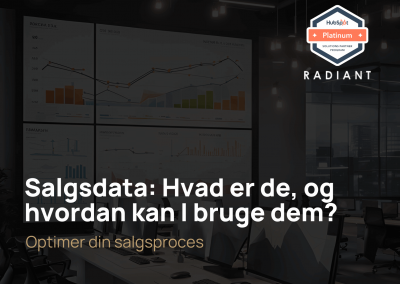A sales pipeline describes the steps in a sales process from the first contact until a sale is made. In this article, we take a closer look at the different phases and explain why pipeline management is an effective tool.
There are seven steps in a sales pipeline, if you use HubSpot as a management tool – namely:
- Lead generation
- Lead nurturing
- Marketing Qualified Lead (MQL)
- Sales accepted lead
- Sales Qualified Lead (SQL)
- Closed deal
- Post-sale
1) Lead generation
Lead generation refers to the process by which a company collects data and information about potential customers. It takes place through various channels – e.g., the website, advertising, social media, demos, whitepapers, podcasts, etc. – and it gives you a unique insight into your potential customers.
The ultimate purpose of lead generation is to expand the companys customer database and increase sales. By following the lead on the companys website, it is possible to target what content will be presented to the leads in the future and, gently, push the person closer to a sale.
RELATED ARTICLE: Manage your sales pipeline with HubSpot
2) Lead nurturing
Selecting specific content for leads is called lead nurturing. With help from marketing automation, you can set up automatic email marketing and other workflows that are tailored to the place of the buying journey your lead is located.
It differs from lead to lead, when they need information and what kind they need. Using lead scoring in HubSpot, you can define a number of factors that provides an overview of how motivated the lead is to make a purchase. You can then use this to target the information you send to the lead.
RELATED ARTICLE: Use lead scoring in HubSpot to increase B2B sales
3) Marketing Qualified Lead (MQL)
Marketing qualified leads – or hot leads as we call them – is a lead that the marketing department has assessed to be open to more targeted marketing. They are not hot enough to become customers yet, but the chance is there, and it is now time to step in.
In this category, one often finds leads who sign up for newsletters, download an e-book, or try out a demo. Once a lead is reached, the marketing department will intensify marketing while notifying the salesperson.
4) Sales Accepted Lead
With a notification from marketing, the sales department now knows, that there is a hot lead that needs attention. It differs from industry to industry and from company to company what works, but it is at this point, that the sales department needs to take action.
With a system like HubSpot, it is possible to make clear guidelines for how the sales process should be approached at this stage. By unifying the work, you ensure efficiency, making it easier to measure the results.
RELATED ARTICLE: 3 ways HubSpot can strengthen your sales process
5) Sales Qualified Lead (SQL)
Sales qualified leads is defined as the stage, where the lead is so hot, that a conversion is just around the corner. The final push depends on the customers buying journey and the companys experience with hot leads. Here, clear procedures are essential for what the sales department should do and when.
6) Closed deal
If all goes well, the lead converts and becomes a customer. After this, the buyers journey must be analyzed, and data obtained to improve the sales and marketing work in the future. Here, HubSpot is also an incomparable tool.
At this stage of the journey, the service must be high. This applies to the scope and implementation as well as any customer support; after all, that is what makes customers come back again and again.
7) Post-sale
Although many companies consider the closed deal as the end of the buyers journey, you may benefit from having another stage in your sales pipeline. Long-term customer relationships secure the bottom line, and with HubSpot, it becomes simple to nurture the contact and keep you fresh in the customers memory.
Use the tools marketing automation offers and continue to offer customers new knowledge, updates, or anything else that can lead to additional sales and committed relationships.
Because, in reality, the sales process starts again – just in the form of additional sales – once the customer has accepted.
RELATED ARTICLE: Make the most of your investment in marketing automation and HubSpot
As HubSpot Partner, we have included steps 1-7 in our Sales as a Service concept
At first glance, each step seems easy, but when you have to have all 7 steps in a harmonious interplay – and in the right order, the complexity increases drastically. In many cases, we have seen situations, where a lot of resources have been spent on developing, implementing, and operating the 7 steps – without the necessary effect. Therefore, we recommend that you get guidance, when you need to embark on a similar sales journey.
At Radiant, you can achieve a sales ecosystem with HubSpot as the foundation and effective sales through our Sales as a Service.



